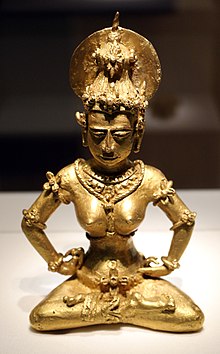
Back Bulawan na Tara BCL Agusan putı CRH Tara Emas ID Tara Dorata Italian เทวรูปอากูซัน Thai Агусан поты Tatar
This article needs additional citations for verification. (May 2019) |
| Agusan image | |
|---|---|
 The Agusan image, 2016 | |
| Material | gold, copper and silver |
| Height | 178 mm (7.0 in) |
| Weight | 2 kg (4.4 lb) |
| Created | 9th–10th Centuries AD |
| Discovered | 1917 Esperanza, Agusan del Sur, Mindanao, Philippines |
| Present location | Field Museum of Natural History |
| Culture | Indigenous Philippine folk religions, Hinduism, Buddhism (disputed in regards to Hindu & Buddhist identity) |
| History of the Philippines |
|---|
 |
| Timeline |
|
|
The Agusan image (commonly referred to in the Philippines as the Golden Tara in allusion to its supposed, but disputed,[1] identity as an image of a Buddhist Tara) is a 2 kg (4.4 lb),[2] 21-karat gold statuette, found in 1917 on the banks of the Wawa River near Esperanza, Agusan del Sur, Mindanao in the Philippines,[3] dating to the 9th–10th centuries. The figure, approximately 178 mm (7.0 in)[4] in height, is of a female Hindu or Buddhist deity, seated cross-legged and wearing a richly-adorned headdress and other ornaments on various parts of the body. It is now on display in the Field Museum of Natural History in Chicago.[5]
Since its discovery, the identity of the goddess represented by the gold statuette has been the subject of debate.[6] Proposed identities of the gold figurine range from that of a Hindu Sivaite goddess to a Buddhist Tara. Recent scholarship suggests that the image represents the offering goddess Vajralāsyā of the Tantric Buddhist tradition.[7][8]
Although the statue was likely first made as either a Buddhist or Hindu deity, it has also been worshipped as an Animist deity and even provided an altar until it was stolen from its place of worship in Agusan del Sur in the early 20th century.[9]
- ^ Francisco, Juan R. (1963). "A Note on the Golden Image of Agusan". Philippine Studies. 11 (3): 390–400. ISSN 0031-7837. JSTOR 42719871.
The question of its identification is still undecided.
- ^ "109928 Agusan gold figure | Philippines | The Field Museum". philippines.fieldmuseum.org. Archived from the original on 30 May 2019.
Description: Agusan gold image of Hindu deity [figure Devi, goddess. A.D. 1000-1300. 4 1/2 pound, solid gold figure of a Hindu or Buddhist deity]
- ^ Francisco, Juan R. (1963). "A Note on the Golden Image of Agusan". Philippine Studies. 11 (3): 390–400. ISSN 0031-7837. JSTOR 42719871.
It was found in 1917 on the left bank of the Wawa River near Esperanza, Agusan, eastern Mindanao, following a storm and flood
- ^ Field Museum of Natural History. "FMNH 109928". collections-anthropology.fieldmuseum.org. Archived from the original on 1 June 2019.
Statue [figure] is about 178 mm in height (FMNH A109928).
- ^ "109928 Agusan gold figure | Philippines | The Field Museum". philippines.fieldmuseum.org. Archived from the original on 30 May 2019.
- ^ Capistrano-Baker, Florina H; Guy, John; Miksic, John N (2011). "Chapter 4 - Butuan in Early Southeast Asia". Philippine ancestral gold. Ayala Foundation; NUS Press. p. 251. ISBN 9789718551745. OCLC 724647223.
From the time the Agusan image first came to light, the identity of the female portrayed has been the subject of conjecture and contention.
- ^ Orlina, Roderick (2012). "Epigraphical evidence for the cult of Mahāpratisarā in the Philippines". Journal of the International Association of Buddhist Studies. 35 (1–2): 165–166. ISSN 0193-600X. Archived from the original on 2019-05-30. Retrieved 2019-05-30.
This image was previously thought to be a distorted Tārā, but was recently correctly identified as a Vajralāsyā ('Bodhisattva of amorous dance'), one of the four deities associated with providing offerings to the Buddha Vairocana and located in the southeast corner of a Vajradhātumaṇḍala.
- ^ Weinstein, John. "Agusan Gold Vajralasya". Google Arts & Culture. Archived from the original on 1 June 2019.
Scholars think that the statue may represent an offering goddess from a three-dimensional Vajradhatu (Diamond World) mandala.
- ^ "Manobo woman's kin want Golden Tara returned". www.philstar.com. August 13, 2018.